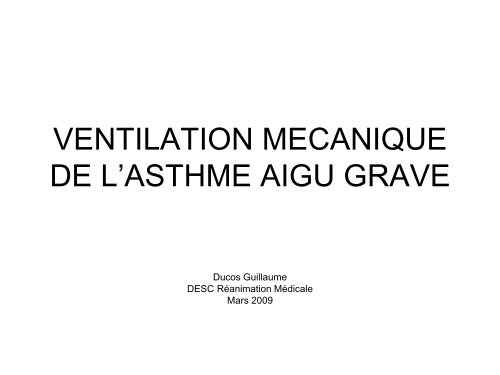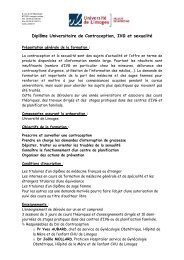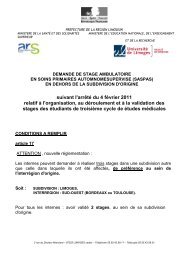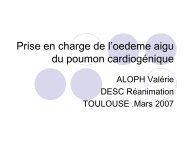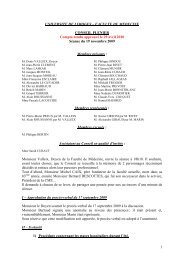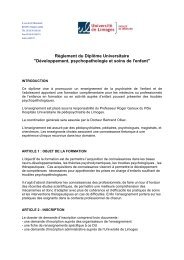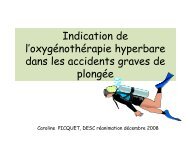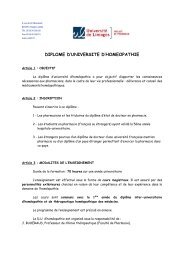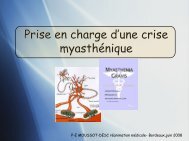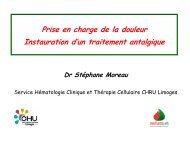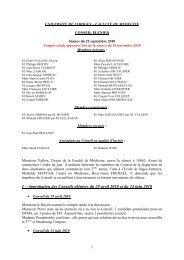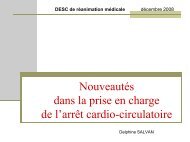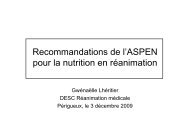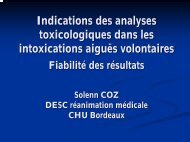VENTILATION MECANIQUE DE L'ASTHME AIGU GRAVE
VENTILATION MECANIQUE DE L'ASTHME AIGU GRAVE
VENTILATION MECANIQUE DE L'ASTHME AIGU GRAVE
You also want an ePaper? Increase the reach of your titles
YUMPU automatically turns print PDFs into web optimized ePapers that Google loves.
<strong>VENTILATION</strong> <strong>MECANIQUE</strong><br />
<strong>DE</strong> L’ASTHME <strong>AIGU</strong> <strong>GRAVE</strong><br />
Ducos Guillaume<br />
<strong>DE</strong>SC Réanimation Médicale<br />
Mars 2009
EPI<strong>DE</strong>MIOLOGIE<br />
En France<br />
3-4 millions d’ asthmatiques<br />
50 000 à 100000 AAG services d’urgence<br />
8000 à 16 000 AAG soins intensifs<br />
1000 sont soumis à une ventilation<br />
mécanique
PHYSIOPATHOLOGIE<br />
• AAG: obstruction bronchique de survenue brutale<br />
ou rapidement progressive liée à un mécanisme<br />
inflammatoire ou un spasme<br />
• Conséquences:<br />
Résistances bronchiques<br />
Pressions inspiratoires<br />
Hypoxémie<br />
Tps expi. = hyperinflation dynamique
PHYSIOPATHOLOGIE<br />
• HYPOXEMIE:<br />
– Non majeure<br />
– Liée à l’effet shunt<br />
– Shunt vrai parfois (obstruction bronchique<br />
totale)<br />
– Bien corrigée par FiO2 entre 0,4 et 0,6<br />
– Si rebelle, autre étiologie à rechercher
PHYSIOPATHOLOGIE<br />
• HYPERINFLATION DYNAMIQUE:<br />
– Résistances expiratoires<br />
– Forces élastiques du parenchyme pulmonaire<br />
Vidange pulmonaire ralentie +++<br />
Tps expiratoire augmenté<br />
Expi. Interrompue par le cycle inspi. suivant: PEPi<br />
Risque majoré par une VM « conventionnelle »
PHYSIOPATHOLOGIE<br />
• HYPERINFLATION DYNAMIQUE:<br />
• P intra-alvéolaire<br />
risque de pneumothorax<br />
• P intra-thoracique<br />
post charge du VD<br />
fonction VG (interdépendance)<br />
majoré par l’hypovolémie et la sédation<br />
risque : ACR par dissociation electromeca.
Levy 1998
Hyperinflation dynamique:<br />
distension thoracique
INTUBATION<br />
• Indications formelles<br />
– ACR, bradypnée/apnée, troubles de vigilance,<br />
cyanose<br />
• Pas d’amélioration ou dégradation sous ttt<br />
• Evaluation clinique<br />
• Pas d’indication biologique
INTUBATION<br />
• Opérateur expérimenté<br />
• Sonde du plus gros calibre possible (8-<br />
8,5)<br />
• Débat sur la voie d’abord (INT vs IOT)<br />
En pratique:<br />
Expansion volémique préalable<br />
Préoxygenation<br />
Induction : Kétamine / propofol / Etomidate<br />
+/- Celo
<strong>VENTILATION</strong> <strong>MECANIQUE</strong><br />
• Objectifs: <strong>VENTILATION</strong> <strong>DE</strong> SECURITE<br />
– Pplateau < 30cm H2O<br />
– SaO2 > 90%<br />
– Pas d’objectif de PCO2<br />
HYPERCAPNIE PERMISSIVE<br />
Feihl F, Perret C, Permissive hypercapnia How permissive should we be? Am J Respir Crit Care<br />
Med 1994 ; 150 : 1722-37
<strong>VENTILATION</strong> <strong>MECANIQUE</strong><br />
• Moyens:<br />
– VAC<br />
– Augmentation de la vidange expiratoire<br />
– Débit inspiratoire ( 80 l/min )<br />
– I/E = ¼<br />
– FR<br />
– Pas de plateau inspiratoire<br />
– Pas de PEP<br />
Tuxen D, Detrimental effects of positive end-expiratory pressure during controlled mechanical<br />
ventilation of patient with severe airflow obstruction Am Rev Respir Dis 1989 ; 140 : 5-9
Paramètres ventilatoires<br />
Réglages<br />
Mode<br />
Ventilation minute<br />
Volume courant<br />
Fréquence respiratoire<br />
Assisté contrôlé<br />
<strong>VENTILATION</strong> <strong>MECANIQUE</strong><br />
• Monitorage<br />
– Clinique<br />
– Paraclinique<br />
• Respi<br />
–Ppic +10% de la valeur initiale<br />
–Vminute bas < 20% de la valeur<br />
théorique
<strong>VENTILATION</strong> <strong>MECANIQUE</strong><br />
• Monitorage<br />
• Hyperinflation dynamique = Vol. exhalé de<br />
Tuxen<br />
– Pause télé expiratoire prolongée ( 60 sec )<br />
Tuxen D, Lane S, The effects of ventilatory pattern on hyperinflation, airways pressures<br />
and circulation in mechanical ventilation of patients with severe air-flow obstruction Am<br />
Rev Respir Dis 1987 ; 137 : 872-9
Tuxen D, Lane S, The effects of ventilatory pattern on hyperinflation, airways pressures<br />
and circulation in mechanical ventilation of patients with severe air-flow obstruction Am<br />
Rev Respir Dis 1987 ; 137 : 872-9
<strong>VENTILATION</strong> <strong>MECANIQUE</strong><br />
• Monitorage<br />
• Hyperinflation dynamique = Vol. exhalé de<br />
Tuxen<br />
– Pause télé expiratoire prolongée ( 60 sec )<br />
– Pause télé expiratoire plus courte<br />
– Pause télé inspiratoire = Pplateau<br />
Tuxen D, Lane S, The effects of ventilatory pattern on hyperinflation, airways pressures<br />
and circulation in mechanical ventilation of patients with severe air-flow obstruction Am<br />
Rev Respir Dis 1987 ; 137 : 872-9
<strong>VENTILATION</strong> <strong>MECANIQUE</strong><br />
• Sevrage<br />
– Stop sédation qd PEPi < 5 mmhg<br />
– Absence de signes de bronchospasme<br />
– Normocapnie<br />
– VSAI ou tube en T<br />
– Rapide<br />
– 24h de surveillance en milieu de réa
<strong>VENTILATION</strong> <strong>MECANIQUE</strong><br />
• VNI<br />
– Non validée<br />
– 1 série décrit des bénéfices…<br />
– … mais pas de groupe contrôle!<br />
– Equipes expérimentées<br />
Meduri GU, Cook TR, Turner RE, Cohen M, Leeper KV, Noninvasive positive pressure<br />
ventilation in status asthmaticus Chest 1996 ; 110 : 767-74
SEDATION / CURARISATION<br />
• « Classique »<br />
• Profonde<br />
• Curarisation possible mais corrélée aux<br />
myopathies de réa<br />
– Discontinue<br />
– Monitorage (TOF)<br />
• Place de la kétamine en entretien<br />
débattue
TRAITEMENTS ADJUVANTS<br />
• Traitement médical maximum<br />
• Halogénés<br />
– Utiles dans les AAG résistants aux ttt conventionnels<br />
• Hélium<br />
– Améliorations de la Ppic et de la PCO2 de brève<br />
durée<br />
– Données trop faibles pour valider une place dans la<br />
PEC de l’AAG
CONCLUSION<br />
• Ventilation de sécurité<br />
• Lutter contre l’hyperinflation<br />
dynamique<br />
• Hypercapnie permissive<br />
• Attention aux barotraumatismes
BIBLIOGRAPHIE<br />
[1] L'Her E, Révision de la troisième conférence de consensus en réanimation et<br />
médecine d'urgence de 1988: prise en charge des asthmes aigus graves de l'adulte<br />
et de l'enfant (à l'exclusion du nourrisson) Réanimation 2002 ; 11 : 1-9<br />
[2] Ventilation mécanique dans l'asthme aigu grave A. Boyer, F. Vargas, G. Hilbert,<br />
D. Gruson SRLF 2009<br />
[3] Tuxen D, Lane S, The effects of ventilatory pattern on hyperinflation, airways<br />
pressures and circulation in mechanical ventilation of patients with severe air-flow<br />
obstruction Am Rev Respir Dis 1987 ; 137 : 872-9<br />
[4] Intubation du patient présentant une crise d'asthme F. Adnet SRLF 2009<br />
[5] Oddo M, Feihl F, Schaller MD, Perret C, Management of mechanical ventilation in<br />
acute severe asthma : practical aspects Intensive Care Med 2006 ; 32 : 501-10<br />
[6] Feihl F, Perret C, Permissive hypercapnia How permissive should we be? Am J<br />
Respir Crit Care Med 1994 ; 150 : 1722-37<br />
[7] Tuxen D, Detrimental effects of positive end-expiratory pressure during controlled<br />
mechanical ventilation of patient with severe airflow obstruction Am Rev Respir Dis<br />
1989 ; 140 : 5-9<br />
[9] Place de la ventilation non invasive dans l'asthme aigu grave A.A. Zeggwagh SRLF<br />
2009<br />
[10] Meduri GU, Cook TR, Turner RE, Cohen M, Leeper KV, Noninvasive positive<br />
pressure ventilation in status asthmaticus Chest 1996 ; 110 : 767-74<br />
[11] Stather DR, Stewart TE, Clinical review: mechanical ventilation in severe asthma<br />
Crit Care 2005 ; 9 : 581-7<br />
[12] Prise en charge de l'asthme aigu grave en réanimation. Quelle place pour l'hélium ?<br />
P. Plaisance SRLF 2009


